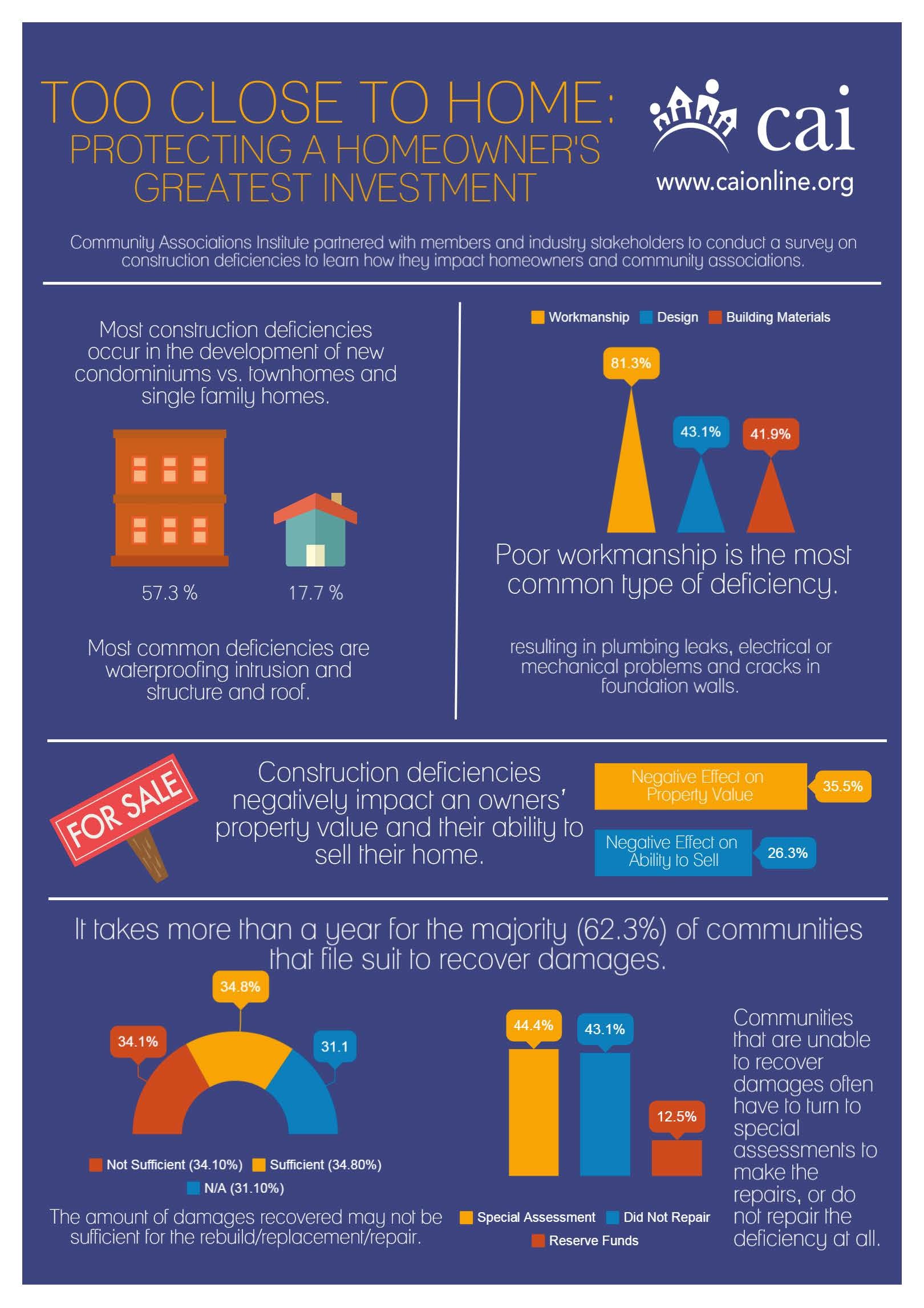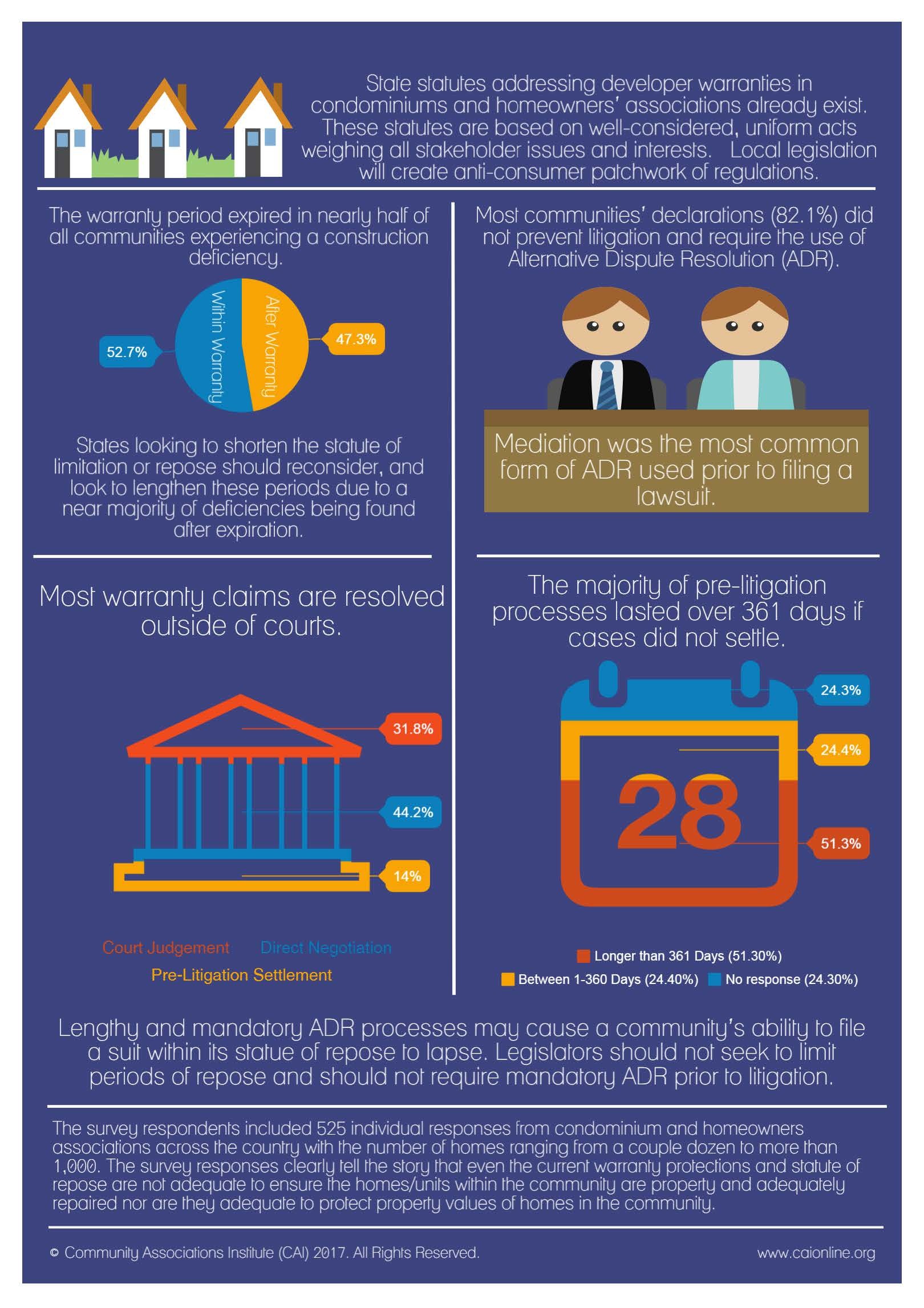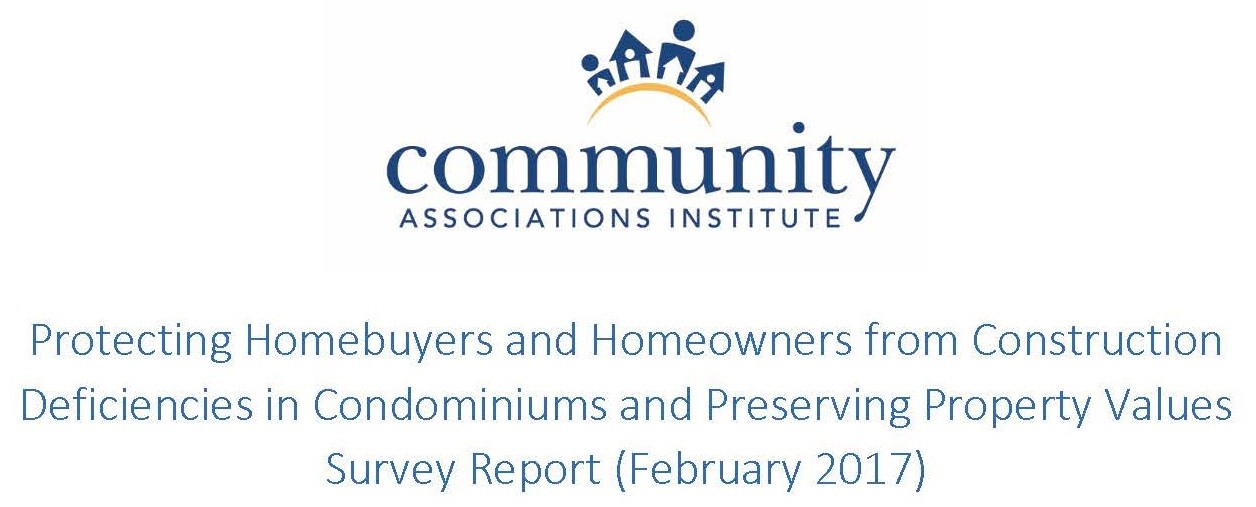The Community Associations Institute (“CAI”) recently partnered with its members and industry stakeholders to create a survey about construction deficiencies to learn how they impact homeowners and condominium associations.
Click here to view the Construction Defects Report Report containing the details of the responses to the survey.
Click here to see a video presentation summarizing the results of the Construction Defects Survey.
This Community Associations Institute (“CAI”) Construction Defects Report demonstrates that many community associations do not discover construction deficiencies until after warranties have expired and/or fail to take the necessary actions to preserve their claims before the statutes of limitations runs. As a result, many homeowners and Condominium associations ended up using association funds to correct builder construction defects and damages caused thereby.
The recommendations from the CAI Construction Defect Survey of community associations are summarized as follows:
Since nearly half of deficiencies are being found after the statute of limitation expires, states should consider lengthening, not shortening, the statutory period.
Consumer protections must remain intact so homeowners who buy into a community and are victim to a deficiency may retain the value of their most important investment: their home.
Legislators must not be swayed by the argument that lessening warranty protections for homeowners will lead to the development of more affordable housing. Construction deficiencies cause property values to drop, sadly making housing affordable at the expense of the homeowner, not the builder. The goal in creating affordable housing is not to lessen current property values, but to create a pathway for new buyers to purchase new homes.
Legislators should not view communities as filing frivolous lawsuits. While the great majority of complaints are resolved without litigation, associations must have the ability to file suit if anything threatens resolution.
Legislators should not view communities as filing frivolous lawsuits. While a vast majority of communities have the right to litigate, most resolve their claims without a court judgement, as reported above. Associations must not be mandated to ADR prior to filing litigation.
Legislators should not seek to limit periods of repose and should not require mandatory ADR prior to litigation. This is because community associations must file legal action within a statutory period. That period can expire during lengthy and mandatory ADR processes.
Association must be permitted alternative repair funding methods during thelengthy periods between suit and recovery. Further, attorney’s fees should be paid for by the party at fault.
Boards of directors and managers (if applicable) should work directly and transparently with the association to identify the defects, gather evidence, document complaints, make temporary repairs and discuss the opportunities available to make the most informed decision on pursuing a claim. As the survey findings indicate, nearly half of all construction deficiencies are resolved through negotiation between the community association and the developer and do not require the expensive approach of litigation.
States or municipalities looking to amend their laws or ordinances should take the following into consideration:
Lengthen the statutory period of limitation and repose.
Strengthen overall warranty protections for homeowners.
Permit associations to make alternative methods for funding repairs.
Permit – not mandate – associations to resolve claims prior to litigation with alternative dispute resolution, specifically mediation.As this study’s finds, stripping the warranty protections for homeowners only increases the cost of homeownership following the sale and will not reduce purchase prices.
Significantly, the CAI Construction Defects Report also demonstrates the importance of early consultation with, and retention of, an experienced construction defect attorney familiar with laws that affect community associations to increase the likelihood of a favorable outcome. Handling construction defect legal claims on behalf of Condominiums and HOAs is a highly complex and specialized area of law. A condominium association’s general counsel may not be the attorney to use when a community association is faced with potentially serious construction defect issues. It is often wise to consider the legal services of a firm that is known for representing condominiums and HOAs in resolving construction defect disputes and has track record and experience in this area.
The full Construction Defect Survey, entitled “Protecting Homebuyers and Homeowners from Construction Deficiencies in Condominiums and Preserving Property Values Survey Report (February 2017),” is reproduced below.
Community Associations Institute (CAI) | Construction Deficiency Consumer Protection Survey Report
©Copyright. All Rights Reserved.
Protecting Homebuyers and Homeowners from Construction
Deficiencies in Condominiums and Preserving Property Values
Survey Report (February 2017)
Introduction………………………………………………………………………………………………………………………… 2
Condominium and HOA Residents Experience with Consumer Protection Warranties – Summary of Findings..3 Discovery and Impact of the Deficiency………………………………………………………………………………………………………………………. 3
- The warranty period expired in nearly half of all communities experiencing a construction deficiency.3 2. Poor workmanship is the most common type of deficiency…………………………………………………………………………………………. 3
- In communities where the statute of limitation or repose had lapsed, communities most often collected a special assessment to fund the repair or did not repair the deficiency at all…………………………………………………………………….. 3
- Construction deficiencies may negatively impact owners’ ability to sell their …………………………….. 4
- Construction deficiencies may have a direct, negative impact on property ……………………………….. 4
- Communities with fewer than 250 homes are most affected by deficiencies……………………………………… 5
- Most common deficiencies included waterproofing, structure and roof ……………………………….. 5
- Most deficiencies occur in the development of new………………………………………………. 5
Claims Against Deficiencies During the Warranty Period…………………………………………………………………… 5
- Most warranty claims are resolved outside of……………………………………………………………….. 5
- Most communities’ declarations do not prevent litigation or require alternative dispute resolution (ADR)….. 6
- Mediation was the most common form of ADR used prior to filing a ……………………………………. 6
- The majority of pre-litigation processes lasted more than 361 days if cases did not settle…………………….. 6
- It takes more than a year for the majority of communities to recover damages………………………………… 6
- The amount of damages recovered may not be sufficient for the rebuild, replacement or ……………. 6
Conclusion – Summary of Recommendations………………………………………………………………………………….. 7
Additional Resources……………………………………………………………………………………………………………… 8
Statement of Practice – Preferred Resolution Method Between Associations and Developers………………………… 8
Community Associations Institute (CAI) | Construction Deficiency Consumer Protection Survey Report
©Copyright. All Rights Reserved. | Page 1 | www.caionline.org
Introduction
Former quarterback and Hall-of-Famer Joe Montana is known for his Super Bowl wins with the San Francisco 49ers, but in August of 2016 his name was in the news for joining another team. He and a group of residents filed a class-action suit against Millennium Partners and Transbay Terminal Developers to recover the losses of property value suffered by the sinking and tilting of the Millennium Tower.
Towering 58 stories above San Francisco’s Financial District, and what has come to be known as “Leaning Tower of San Francisco,” the Millennium Tower has sunk 16 inches into the soil and titled 2 inches to the northwest since opening in 2009. It is expected to sink an additional 8-15 inches in the coming years. The city’s attorney Dennis Herrera called the situation “every homeowner’s worse nightmare.” (Robinson, 2016)
The Millennium Tower is a high-profile case highlighting construction deficiencies. It is because of its status and those involved that it received media attention. Unfortunately, the residents of the Millennium Tower are a few among thousands of homeowners every year discovering they are living their own worst nightmare. The consequences of builders’ negligence and material deficiencies are causing thousands of homeowners around the country every year to file claims seeking repairs for damages of their most important investment: their home.
Yet many developers around the U.S. are seeking refuge from these claims by pushing legislation to weaken building warrant laws that protect consumers. To add insult to the attempts, many developers are encouraging this legislation under the guise that these protections are making it too costly to build affordable housing.
The legislation being pushed in the states has similar trends. The legislation will make it more difficult for homeowners to collect damages, either requiring them to pursue alternative dispute resolution or requiring higher percentages of homeowner approval before filing legal action. Not only do these requirements cause delay in repairs, but they permit developers to postpone repairs long enough to fall outside of the states’ statute of limitations and repose. Further the legislation proposes to shorten the warranty period as well the deadline to file a claim once the defect is found. Legislation further attempts to redefine a defect as only those that cause physical harm, a would-be metaphorical punch to the gut of Millennium Tower residents.
It is because of this recent trend in legislation that Community Associations Institute (CAI) partnered with its members and industry stakeholders to create a survey about construction deficiencies to learn how they impact homeowners and community associations. This report details the responses of the survey.
Community Associations Institute (CAI) | Construction Deficiency Consumer Protection Survey Report
©Copyright. All Rights Reserved. | Page 2 | www.caionline.org
Condominium and HOA Residents Experience with Consumer Protection Warranties – Summary of Findings
CAI partnered with its members and industry stakeholders to draft a survey on construction deficiencies to learn how they impact homeowners and community associations.
SURVEY RESPONDENTS: The survey respondents included 525 individual responses from condominium and homeowner associations across the country with the number of homes ranging from a couple dozen to more than 1,000.
The survey findings clearly tell the story that even the current warranty protections and statutes of repose are not adequate to ensure the homes within the community are properly repaired. Further, current protections are inadequate to maintain home property values and show that lowering these protections will only increase the cost and burden of homeownership, a stark contrast to builders’ claims that these provisions prevent the construction of affordable housing.
Discovery and Impact of the Deficiency
1. The warranty period expired in nearly half of all communities experiencing a construction
47.3% of communities identified a construction deficiency after its warranty period.
52.7% of communities identified a deficiency within its warranty period.
Recommendation: Since nearly half of deficiencies are being found after the statute of limitation expires, states should consider lengthening, not shortening, the statutory period.
2. Poor workmanship is the most common type of *
81.3% identified the deficiency was in construction. Poor workmanship resulted in plumbing leaks, electrical or mechanical problems and cracks in foundation walls.
46.1% of respondents identified a deficiency in design. Architects and engineers may have designed buildings and systems that did not work as intended.
41.9% of respondents reported a deficiency in building materials. In this case the building materials were defective or damaged and lead to the deficiency.
3. In communities where the statute of limitation or repose had lapsed, communities most often collected a special assessment to fund the repair or did not repair the deficiency at all.
44.4% of respondents to this question paid for the repair through a special assessment. Special assessments increase the cost of homeownership.
43.1% did not repair the deficiency.
The remainder paid for the repairs by using reserve funds, if permissible. Association covenants generally require that reserve funds be spent on capital improvements, not repairs.
Community Associations Institute (CAI) | Construction Deficiency Consumer Protection Survey Report
©Copyright. All Rights Reserved. | Page 3 | www.caionline.org
4. Construction deficiencies may negatively impact owners’ ability to sell their home.
26.3% of respondents claimed a construction deficiency negatively impacted their ability to sell their home due to the lack of mortgage financing.
44.6% responded that the deficiency did not impact the sale of their home.
29.1% of respondents were unsure.
Respondents were allowed to comment on the question. Here are some notable comments:
- “Due to litigation – owners were unable to refinance or sell.”
- “When the board disclosed the situation, property values were slashed in half. ”
- “It has been horrible, but it hasn’t stopped people from wanting to They just can’t get conventional financing.”
- “Realtors did not want to show or even list the home because of the construction issues. ”
- “Due to the area of the community being a very desirable neighborhood, it has not currently affected any of the homes resale value or ability to arrange mortgage financing. ”
- “From the time we filed the suit until repairs completed it was over 3 years, so no one could refinance and no bank would loan while a suit was in place.”
- “One home was demolished by a No one could sell.”
- “2 possible sales Original cost $249,000. Now one unit on sale for $99,000.”
Recommendation: Consumer protections must remain intact so homeowners who buy into a community and are victim to a deficiency may retain the value of their most important investment: their home.
5. Construction deficiencies may have a direct, negative impact on property value.
35.5% of respondents reported the deficiency had a direct, negative impact on their property value.
36.2% claimed property values did not suffer a direct, negative impact.
28.1% were unsure
Many comments explained that there was no impact on property value since homes were not sold during the litigation or repair process. Here are some other notable comments:
- “With close to 60 units selling each year during the construction defect process, lending was challenging but sales continued and the impact on selling price was not drastic.”
- “Owners who sold lost from 12% to 29% of their original investments at time of sale.”
- “It is considered an affordable housing community, so they are in high demand, even with known issues. ”
- “Property value was negatively impacted by both the disclosure of the deficiency/repair and the drain on the reserve finds.”
- “It’s almost impossible to sell homes, everyone is trying to leave because they think there are a bunch of other major issues.”
- “Tax relief obtained for diminished value based on initial engineer’s report.”
Community Associations Institute (CAI) | Construction Deficiency Consumer Protection Survey Report
©Copyright. All Rights Reserved. | Page 4 | www.caionline.org
Recommendation: Legislators must not be swayed by the argument that lessening warranty protections for homeowners will lead to the development of more affordable housing. Construction deficiencies cause property values to drop, sadly making housing affordable at the expense of the homeowner, not the builder. The goal in creating affordable housing is not to lessen current property values, but to create a pathway for new buyers to purchase new homes.
6. Communities with fewer than 250 homes are most affected by deficiencies.
On average 75.7% of respondents live in a community with fewer than 250 homes. On average 35.1% of respondents live in a community with 101-250 homes. On average 18.8% of respondents live in a community with fewer than 50 homes.
7. Most common deficiencies included waterproofing, structure and roof problems.*
48.2% reported a deficiency in waterproofing.
38.6% and 38.5% of respondents reported a deficiency in their structure and roof, respectively.
Those respondents whose deficiency was discovered within their warranty period reported more deficiencies found in the roof (42.3% to 34.8%) and fewer deficiencies found in the structure (37.3% to 39.9%) than those respondents whose defects were found outside of their warranty period. Decks as well as common areas likely hallways, stairwells, and clubhouses, were reported less. Plumbing was also reported as an additional comment.
8. Most deficiencies occur in the development of new condominiums.
57.3% of respondents reported a deficiency occurred in a new condominium. This is opposed to converted condominiums, townhomes, mixed-use associations and single-family homes.
17.7% reported the deficiency was found in a townhome and 9.5% in single-family homes.
Claims Against Deficiencies During the Warranty Period
9. Most warranty claims are resolved outside of courts.*
14% of respondents whose deficiency was discovered during the warranty period resolved their claim by court judgement.
44.2% were resolved with direct negotiation.
31.8% were resolved with a pre-litigation settlement.
16.2% were resolved using alternative dispute resolution.
Recommendation: Legislators should not view communities as filing frivolous lawsuits. While the great majority of complaints are resolved without litigation, associations must have the ability to file suit if anything threatens resolution.
Community Associations Institute (CAI) | Construction Deficiency Consumer Protection Survey Report
©Copyright. All Rights Reserved. | Page 5 | www.caionline.org
10. Most communities’ declarations do not prevent litigation or require alternative dispute resolution (ADR).
82.1% of respondents whose deficiency was discovered during the warranty period reported their association declaration did not prevent them from filing a lawsuit or require ADR.
Recommendation: Legislators should not view communities as filing frivolous lawsuits. While a vast majority of communities have the right to litigate, most resolve their claims without a court judgement, as reported above. Associations must not be mandated to ADR prior to filing litigation.
11. Mediation was the most common form of ADR used prior to filing a lawsuit.
23.5% of respondents whose deficiency was discovered during the warranty period attempted mediation prior to filing suit.
57.1% of those who filed a lawsuit did not use any pre-litigation procedures.
12. The majority of pre-litigation processes lasted more than 361 days if cases did not settle.
51.3% of respondents whose deficiency was discovered during the warranty period reported the pre- litigation process as lasting longer than 361 days.
Recommendation: Legislators should not seek to limit periods of repose and should not require mandatory ADR prior to litigation. This is because community associations must file legal action within a statutory period. That period can expire during lengthy and mandatory ADR processes.
13. It takes more than a year for the majority of communities to recover damages.
62.3% of respondents whose deficiency was discovered during the warranty period did not recover damages within 1 year.
12.1% recovered damages in less than a year. 19.3% recovered damages in 3-5 years.
34.9% recovered damages in 1-2 years.
8.4% reported did not recover damages for than 6 years (6% reported 6-10 years to recover, and 2.4% reported more than 10 years to recover).
Recommendations: Association must be permitted alternative repair funding methods during thelengthy periods between suit and recovery. Further, attorney’s fees should be paid for by the party at fault.
14. The amount of damages recovered may not be sufficient for the rebuild, replacement or repair.
34.1% of respondents whose deficiency was discovered during the warranty period reported the amount of damages recovered was not sufficient for repair.
34.8% reported it was sufficient for repair.
31.1% responded the question did not apply.
Community Associations Institute (CAI) | Construction Deficiency Consumer Protection Survey Report
©Copyright. All Rights Reserved. | Page 6 | www.caionline.org
Conclusion – Summary of Recommendations
Boards of directors and managers (if applicable) should work directly and transparently with the association to identify the defects, gather evidence, document complaints, make temporary repairs and discuss the opportunities available to make the most informed decision on pursuing a claim. As the survey findings indicate, nearly half of all construction deficiencies are resolved through negotiation between the community association and the developer and do not require the expensive approach of litigation.
States or municipalities looking to amend their laws or ordinances should take the following into consideration:
- Lengthen the statutory period of limitation and repose.
- Strengthen overall warranty protections for homeowners.
- Permit associations to make alternative methods for funding repairs.
- Permit – not mandate – associations to resolve claims prior to litigation with alternative dispute resolution, specifically mediation.
As this study’s finds, stripping the warranty protections for homeowners only increases the cost of homeownership following the sale and will not reduce purchase prices.
*Respondents were allowed to select more than one answer to the question.
Community Associations Institute (CAI)
Government & Public Affairs Department
government@caionline.org (888) 224-4321
Published January 2017
Revised February 2017
Community Associations Institute (CAI) | Construction Deficiency Consumer Protection Survey Report
©Copyright. All Rights Reserved. | Page 7 | www.caionline.org
Additional Resources
Statement of Practice – Preferred Resolution Method Between Associations and Developers
Ross Feinberg, Esq., and Ron Perl, Esq. describe the complexities of construction deficiencies well in the introduction to their book, Construction Defect Litigation:
“Developers and contractors are professionals whose businesses are challenging under even the most ideal conditions. Residential development and construction are made all the more complex by fierce competition for resources, a shortage of qualified labor, an erratic economy, and incessant market demands.
Developers and contractors dislike construction defect litigation as much as homeowners do, and most will make genuine efforts to resolve problems quickly and efficiently—if you let them.
Whether a defect is severe enough to warrant legal action depends on which side of the contract you signed. For the homeowner, understandably, all defects are serious; but, from a practical standpoint, most probably aren’t serious enough to require a lawsuit. Constructive negotiations with the developer, builder, or contractor nearly always lead to resolution. In fact, most construction defects are resolved without legal action—and for good reason. Litigation is extremely costly. Associations and homeowners must compare the cost to repair construction defects against the cost to argue about them.
Although we are attorneys, we’re not encouraging readers to rush to the courthouse at the first sign of damage. On the contrary, we encourage you to pursue friendly resolution with your developer or contractor, let them make repairs, and consider all non-legal options seriously before you file suit. However, for the unfortunate minority who find themselves faced with litigation, we intend this book to provide enough guidance to make the process as productive and positive as possible—not only for homeowners and associations, but also for developers, contractors, and others involved in the process.
For common-interest developments, also known as community associations, an already complex process can be aggravated by added layers of governance and operation. Thus, the association’s manager and its board become key players in the litigation process. It’s a complicated, time-consuming process they generally know little about. For self-managed associations, board members also serve as managers who not only aren’t experts on litigation, but also may not have a firm grasp on governing and operating their associations.
In some cases, association boards consist of developer directors (because as owner of the unsold homes, the developer has a vested interest in governing the association) and homeowner directors. These are associations in transition. The balance of governance gradually shifts toward homeowner directors as properties sell, but resolving construction defects during the transition stage presents unique challenges because developers and homeowners are likely to have different interests. Addressing the specifics of the transition process is beyond the scope of this book; however, the process for resolving defect claims described here applies to those in transition and should prove very useful.”
Community Associations Institute (CAI) | Construction Deficiency Consumer Protection Survey Report
©Copyright. All Rights Reserved. | Page 8 | www.caionline.org
CAI Public Policy – Protection of Association Claims in Construction Defect Legislation
Public Policy Summary
Builders that construct homes and common elements for purchase by consumers must be required to deliver a product that is free from material defects and exhibits good workmanship. Builders rely on design professionals and subcontractors (hereafter referred to as “Construction Affiliates”) to deliver homes and common elements that meet those standards.
CAI recognizes the importance that homeowners have reasonable expectations of the quality of construction of their homes. CAI supports legislation and regulations concerning construction defects that adequately balance the rights and responsibilities of community associations, their governing boards, homeowners, builders and construction affiliates. The full policy statement may be found here or at www.caionline.org/publicpolicies/.
Community Associations Institute (CAI) | Construction Deficiency Consumer Protection Survey Report
©Copyright. All Rights Reserved. | Page 9 | www.caionline.org

1321 Generals Highway, Suite 302, Crownsville, MD 21032
Bing Places • Google • Facebook





